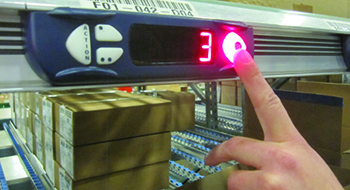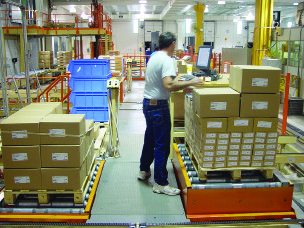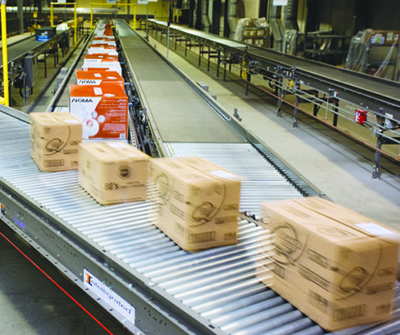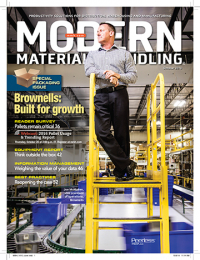Best Practices: Reopening the case
Mature case-picking operations might not seem like fertile ground for substantial improvements, but new approaches to old favorites can offer big rewards.
As distributors scramble to develop piece-picking capabilities in response to e-commerce demands, the case-picking area has fallen out of the limelight. A handful of mature case-picking methodologies like manual picking to pallets and picking to conveyor meet most needs, and few can justify the leap to highly automated storage and retrieval or goods-to-person case-picking systems. However, a growing range of technologies are designed to boost the effectiveness of familiar approaches and target the sizable space between manual and automated solutions.
“There is a lot of low-hanging fruit for case-picking operations,” says Norm Saenz, managing director at St. Onge Co. “There are still plenty of retailers picking more cases than anything else, and in the last few years, we’ve seen solutions emerge that they will want to take a close look at.”

In addition to the classic objectives of accuracy and productivity with the least labor possible, some important drivers are behind the efforts of solution providers and end-users to revisit case picking. Ergonomic concerns are a more pressing concern than ever when designing everything from storage locations and materials handling equipment to user interfaces for hardware and software. Software systems are increasingly expected to make dynamic decisions to optimize labor and inventory allocation. And, of course, all of these systems should include redundancies to ensure continuity and be ready to address seasonal peaks and valleys.
“There has been an overemphasis on piece picking, when in most cases a facility will have a mix of both piece and case picking,” says Ken Ruehrdanz, manager of the distribution systems market for Dematic North America. “I’ve seen facilities with very elegant automated piece picking, but case picking is done in a very conventional way. It’s something that doesn’t seem as exciting, but I think that’s going to change.”
Something old, something new, something borrowed
The most basic case-picking process consists of pulling or riding a pallet jack down an aisle and stacking cases on a pallet for a discrete order. To add a layer of accuracy and productivity, voice-directed solutions can replace paper-based labeling to offer hands-free picking. Ruehrdanz says that by some estimates the number of companies using paperless picking is already a majority, and that “if they’re not using voice or RF now, they probably will be soon.”
Until recently, according to Saenz, the next level of sophistication was picking to a conveyor that delivers cases to a sorter for consolidation and pallet assembly at the dock.
“What’s come along in the last few years is all sorts of driverless or semi-automated forklift technologies,” says Saenz, who offers the examples of Dematic’s FlexTruck, Toyota’s Pick-n-Go, Crown’s QuickPick Remote and Seegrid’s SafetyPick. “The purpose of these technologies is to take a traditional setup and the existing layout and infrastructure but reduce the number of times a picker has to get on and off the lift truck. A few seconds per pick makes a big difference and can increase productivity by 10%. This is a huge evolution I don’t think a lot of companies know about.”
In some cases, the semi-automated forklifts can take a full pallet to the dock, creating another productivity boost because the picker can continue to pick instead of travel. Saenz says driverless options fit nicely into the gap in cost and complexity between voice-directed case picking and conveyor-based solutions.
That said, driverless solutions that keep a picker picking present a risk of fatigue. Cases are generally heavy, and although travel time to and from the dock does not add value, it might serve as a short break for the picker. When designing a process, constraints on case weights or cumulative weights over the course of the shift are important factors to consider. Ruehrdanz says that formal regulations may only become stricter, and North American companies might look to Europe for examples of what to expect in the future.
“It’s tough work on the body, and designers and engineers want to facilitate happy places for people to work,” he says, “especially when it’s getting more difficult to find labor.”
Jeff Ross, vice president of consulting for Forte Industries, identifies some common missteps in facility design that can compromise picker comfort. When possible, it’s ideal to avoid picking and replenishing in the same aisles, which can be accomplished by using pallet flow racks. Ross says another common mistake is to not allow proper space for the picker to access the pallet. By using a minimum beam height of 6 feet, the picker can more comfortably access cases toward the rear of the location.
In a pick module where pickers put cases on a conveyor, Ross admits that an additional touch is then required to palletize after sorting. However, the extra handling is performed at the consistently ergonomic height of the conveyor. Lift tables can be used to further reduce strain at after-sort lanes.
Once you have comfortable and productive pickers, consider the software orchestrating the work behind the scenes. Voice-directed systems, driverless or semi-automated solutions and automation all require robust information technology systems, but Saenz says the integrity of the data in those systems is a struggle for many companies.
“It’s often frustrating to get the most out of the warehouse management system (WMS), where you would think accurate product information is available, but the optimal capturing of pallet, case and piece characteristics has not always found its way to the systems in DCs,” he says. “This hurts the ability to do slotting, palletizing and cubing.”
A marriage of technologies
Any technology applied in an environment with poor slotting will not work well, Saenz says, and effective slotting alone can have a big impact on productivity in the case-pick area. In automated systems where productivity is more consistent, the software functionality becomes important. Conventional case-pick modules with sorters are mature methodologies, but can be inflexible.
According to Ross, an emerging best practice is to scan and direct products through an automated system by the UPC rather than a label. This is because when a label is affixed at the moment of picking, its destination is predetermined and unchangeable. This means a decision has been made about the ideal destination, say, 20 minutes before it arrives there. If cases are tracked by UPC instead, postponement techniques can enable dynamic inventory allocation. A case on the conveyor or sorter can then remain available for any order. For example, in the event of a stockout or other pick exception, a case already in motion might be redirected to the highest-priority order. In addition, postponement techniques can ensure a balanced workload at the after-sort lanes.
“It can be very valuable to postpone those decisions for 10 or 15 minutes and make them on the fly, but it’s dependent on good quality UPCs, and not all customers have that,” Ross adds. “The more you can let the software make the decision instead of the label, the better off you’ll be. From a software perspective, postponement decisions are the most significant opportunity to improve existing case-picking operations.”
Companies might need to press suppliers for consistent and quality UPCs, but Ross says postponement decisions can still be factored into the control logic with a labeling system. This simply requires less rigid rules than “a box with X label always goes to lane one.”
Once the cases arrive at the after-sort lane, technologies like RF, voice-directed, light-directed or a blend of each have proven effective for consolidation, accuracy and productivity. Ideally, the software systems behind the technology used in picking, sorting and shipping are tightly integrated. According to Doug Mefford, product manager at Intelligrated, that integration is no longer the chore it once was. 
“With advances in software throughout the supply chain domain, the ability to implement software into a consistent environment becomes less difficult,” Mefford says. “You can have various platforms, voice, RF and light all working together.”
In fact, it is advantageous to blend technologies to satisfy the specific SKU and order profiles in a given facility. The density of picks is a good determining factor between voice or hands-free, Mefford says, since if the pick density is too great, voice can be limiting while a picker waits for instructions. Lights can provide more immediate information, and RF can be folded in to address non-frequent transactions, replenishment or putaway. Mefford adds that a mix of technologies can help make operations resilient to future changes, as well as unexpected disruptions.
“If you lose RF, what’s your fallback position?” he asks. “Or, say you’re using light-directed technology and for some reason the lights fail and can’t be diagnosed immediately. What is your redundant process for physical failures? The right solution will allow you to adapt and continue to work.”
Integrated technologies can also enhance the flexibility of the labor pool. During seasonal peaks that require temporary labor, user-friendly and consistent interfaces enable quick on-boarding, but they also support cross-training and versatility. Companies don’t want a month of ramp-up time for temp labor, Mefford says, nor do they want highly trained employees twiddling their thumbs in the off-season.
“Our customers want to flex the staff and the facility to thoughtfully ramp up based on historic trends and future predictions,” he says. “Many are working to align processes around picking regardless of the requirement, whether wholesale, retail or direct-to-consumer. Unifying processes allows cross-training, and the user experience is becoming a really big factor to define the consumption of work. It’s a driver at the forefront of delivering solutions.”
Companies mentioned in this article:

Article Topics
Ergonomics News & Resources
Advance Lifts marks 50th anniversary Shift Robotics demonstrates warehouse Moonwalkers HeroWear demonstrates a back-assist exosuit SIGI announces key leadership promotions Autoquip Corporation acquires German company J.A. Becker & Söhne Monorail Manufacturers Association celebrates 90 years of monorail best practices Caster Concepts expands manufacturing facility in Albion, Mich. More ErgonomicsLatest in Materials Handling
ASME Foundation wins grant for technical workforce development The (Not So) Secret Weapons: How Key Cabinets and Asset Management Lockers Are Changing Supply Chain Operations MODEX C-Suite Interview with Harold Vanasse: The perfect blend of automation and sustainability Consultant and industry leader John M. Hill passes on at age 86 Registration open for Pack Expo International 2024 Walmart chooses Swisslog AS/RS and software for third milk processing facility NetLogistik partners with Vuzix subsidiary Moviynt to offer mobility solutions for warehouses More Materials HandlingAbout the Author
Subscribe to Materials Handling Magazine

Find out what the world's most innovative companies are doing to improve productivity in their plants and distribution centers.
Start your FREE subscription today.
April 2024 Modern Materials Handling

Latest Resources












